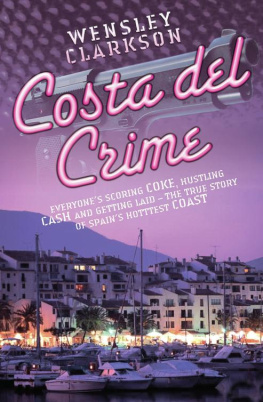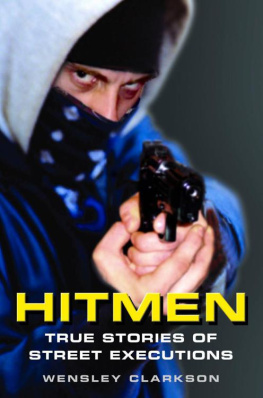T he number of hitmen on our streets today has reached epidemic proportions. Twenty years ago there was only a small crew of highly professional killers for hire carrying out a handful of hits. Yet by the beginning of the new century, there were more than one hundred paid-for murders in Britain each year.
But you wouldnt always guess it by reading the nations newspapers. Professional hits get little coverage. As Fleet Street crime hack Peter Wilson says, One villain knocking off another doesnt have the same news appeal as a beautiful brunette blasting her cheating hubby to death.
Genuinely professional hitmen revel in the low-key nature of their business. Says one, The less publicity the better. The papers dont seem that interested in most hits. The biggest coverage I ever got was a few lines in the Standard.
In the past, even the police played down hits on criminals. As one retired detective recently explained: We took the attitude that every time there was a hit that meant one less villain on the streets and that cant be a bad thing.
But now even the forces finest admit the situation has got out of control. Scotland Yard has a special secret squad to investigate these criminal renegades. David Veness, assistant commissioner in charge of specialist operations, admits, We have a genuine fear that there is a greater capacity for criminals to gain access to individuals willing to kill for money. There are worrying signs that there are small groups for whom this is the main form of criminal activity. Thats copspeak for Its a big problem.
The bottom line is that lifes a lot cheaper now than it was when sawn-off shotgun-toting armed robbers swaggered across pavements taking pot shots at The Sweeneys John Thaw and Dennis Waterman as they crouched behind their Ford Granada. A lot of its down to puff, E and coke, says south-east London criminal Gordon McShane. Many of the robbers of the Seventies are now dealing drugs big time. Were talkin about millions of quid changing hands. That means the rotten apples need to be dealt with. Theres no shortage of work for a decent shootist.
THE PROFESSIONALS
These are the characters who come up through the ranks to become professional hitmen. Their so-called skills are known to the countrys most powerful underworld gangsters. They keep a low profile and tend to live anonymous, almost normal lives. They also tend to only hit other criminals and avoid the high-profile jobs that end up in the tabloids. These pros thrive on the fact that their line of work is low profile and often hold down more respectable careers within the traditional criminal fraternity. Many are so low-key its virtually impossible for police to prove a link between them and the murders they have committed.
YARDIES
There is a smack-crazed posse of West Indian gangsters who dispose of rivals and, sometimes, their families with cold-blooded, execution-style killings that serve as a warning to anyone who dares to double-cross them in drug deals. Often their hitmen target rival drug dealers, rip off their produce and then wipe them out. As a final calling card they have been known to sexually assault their victims, whether male or female. In June and July 1998, the Yardies carried out three barbaric murders, including the execution of two young mothers. Scotland Yard linked the slayings after forensic tests revealed the victims were shot with the same 9mm self-loading handgun.
TRIADS
This gang, with its sickening brand of maiming and killing rival gang members, has been operating on Britains streets for the past 30 years. But most of these murders go unreported and unsolved because of the Triads Mafia-style secrecy and the fears of those within the Chinese community. Four main Triad societies, the 14K, We On Lok, Wo Shing Wo and San Yee On, rake in vast profits from protection rackets, prostitution, fraud, illegal immigration and illicit gambling. The Triads train up their own hitmen by importing previously unknown individuals from the Chinese mainland.
THE OPPORTUNISTS/SEMI-PROS
These are small-time hoods prepared to knock off other villains, cheating lovers and work rivals. They underprice the pros and are often desperate for cash to feed a drug or drink habit. One recent classic example of this was when the shooter intended to hit a little boys stepfather whod double-crossed local drug lords instead the youngster was shot dead. These hitmen are more often caught because they dont think through the science of being a hired killer and take necessary precautions. And, chillingly, some of them are mere teenagers prepared to kill for a few hundred pounds.
These categories are just the tip of the iceberg. The cold, hard reality is that hitmen can come from every type of background and, as this book will show, they share one common factor: an appalling lack of regard for human life.
Wensley Clarkson 2005
M aori Te Rangimaria Ngarimus face had the bone structure of a warrior but she possessed the body of a beautiful young woman. Her lovers all praised her sensuous nature and her fondness for steamy sex, and her bubbly personality helped land her the nickname Sparky. Te was 24 years old, confident, well educated with a double first from a university back in New Zealand and enjoying her life in Britain so much that she planned to stay for at least the next five years.
But Sparkys shapely body was well hidden by the baggy black tracksuit, sunglasses and baseball cap she wore in May 1992, as she strolled into the Royal Free Hospital in Hampstead, north London, to visit a sick friend. Sparky managed a typically pleasant smile at the nurse who kindly directed her towards the main mens ward.
Sparky calmly pressed the lift button as she waited alongside a mother with her young child and two elderly women. Once inside the elevator she pressed number three, turned and glanced casually at the other visitors as the lift slowly rose to the third floor. When the doors opened she slid her hand into her handbag to check on the contents.
Then Sparky walked out into the corridor, and looked to her right and left before recognising the man shed come to see. He was leaning casually up against a wall with a phone virtually glued to his ear while he talked quietly into the receiver. As Sparky began walking towards him, he turned his back to her, but she already knew for sure it was him. Shed studied his photograph closely the previous week and then followed him from his home to make sure she knew exactly what he looked like in the flesh. Sparky walked right past him as he continued talking into the phone. Another ten yards and Sparky casually turned around for one last glance.
Then she reached into her handbag and kept her hand buried inside it as she strolled back towards where he was standing. But just then something stopped her, she turned away and walked back towards the lifts, still grappling in her handbag. She firmly pushed the button to call the lift. Her target was just three feet from her. Now was the perfect moment. She flicked the safety catch on the gun in her handbag.
Graeme Woodhatch only noticed Sparky as she pulled the .22 pistol from her bag and aimed it straight at him, holding the weapon with both hands. His mouth fell open and started to move as she squeezed the trigger. His scream was drowned out by the explosion. Woodhatch tried to cover his face with his hands as the first bullet smashed into the centre of his forehead, another ricocheted off his backbone and severed an artery, a third demolished the bridge of his nose and the fourth embedded itself in his shoulder.














